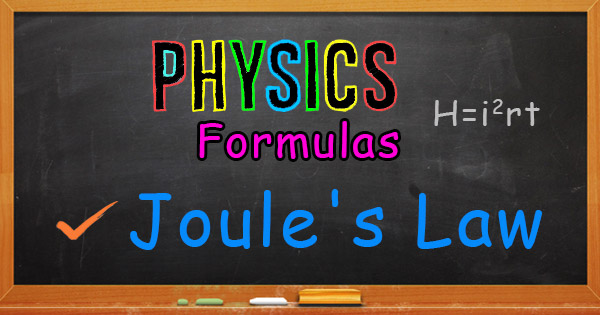
We know that the heating impact of electric current when it travels in a circuit is because of collision among electrons of wire. Specifically, what is the amount of heat generated during the flow of current through a wire and what are the parameters and conditions it is based upon. To answer all these questions, Joule gave a formula that describes this phenomenon precisely and called as Joule’s Law.
Joule’s Law of Heating
The heat that is generated because of the current flow in an electric wire is described in Joules. The mathematical expression of Joule’s law is as explained below.
Joule’s first law
The joule’s first law shows the relationship between heat produced by a flowing electric current through a conductor.
H = I2 R T
Where,
H indicates the amount of heat generated
I show electric current
R is the amount of electric resistance in the conductor
T denotes time
The amount of generated heat is proportional to wire’s electrical resistance when the current in the circuit and the flow of current is not changed.
The amount of generated heat in a conductor carrying current is proportional to the square of the current flow through the circuit when the electrical resistance and current supply is constant.
The amount of heat produced because of the current flow is proportional to the time of flow when the resistance and current flow is kept constant.
Practical Application of Heating Effect of Electric Current
The use of heating effect of electric current is made in various appliances, called the electric appliances, in industrial heating, welding, space heating and in electrical installation protection.
The most familiar example of practical electrical heating is the metal filament lamp through which, when current is passed its filament gets heated to such a high temperature that it emits the visible radiations called the light.
Familiar domestic applications are the electric kettles, electric stoves, electric irons, electric percolators, the electric cookers etc. Every heating appliance is built around a heating element (or elements) consisting essentially of a spiral high resistivity alloy such as nichrome, which generates heat on passing of electric current through it.
Electric heating is also preferred over other methods of heating in industry owing to its inherent advantages. Electric ovens are in common use in large bakeries, electric kilns bake earthen ware and china, while electric furnaces are used for several purposes, such as for the melting of metals and the annealing of tools. The heat of the electric arc in welding has brought a revolution to the various metal industries. An electric arc is an electric discharge in gases accompanied by high heat and a bright glow and is formed when two conductors, called the electrodes, are brought together to make an electric contact and then separated.
Recent applications are the heating and conditioning of the air in large buildings, and what is called ‘space heating’, in which open fires or radiators are replaced by tubular electric heaters of about 51 mm diameter and taking about 16,000 Watts per meter run.
Safety fuses and thermal relays, which are used for the protection of electrical installations against overheating, also operate on the heating effect of electric current. A fuse is a length of wire or of strip (copper, lead or silver) of low melting point placed in a circuit to get heated and melt when the current through it has reached a pre-determined value.
Remember these conversions,
1 kcal = 4,200 J
1 joule = 1 watt-second
1 kWh = 860 k cal
1 kWh = 1,000 watt-hours
Check the list of all Physics Formulas here. For Biology, Physics, Maths, English, GK etc please check respective sections of CheckAll.in. You can now subscribe here for free, to get notification regarding new posts.
For Brain Exercise, play “Math Addict – Brain Training Game” regularly. Click here to get the game.
Here are some exercise problems with solutions for you.
Solved Problems using Joule’s Law Formula
Problem 1: How much heat is produced by 2 kW electric heater when it is operated for 30 minutes.
Answer:
Heat Produced, H = Rating in kW x times of operation
= 2 kW0.5 hour = 1 kWh
= 36×105joules or 860 k cal